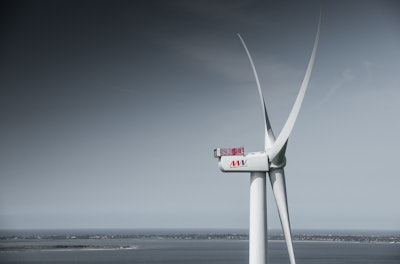
Mitsubishi Heavy Industries is betting on wind power becoming a $1 billion business in the United States. In January, MHI America President and CEO Takaoki Niwa spoke on seeing wind as a growing part of the company’s portfolio as part of a press tour of MHI’s operations in Houston.
Niwa said the industry can expect a “sharp increase in renewable energy.”
“The key word is, low or carbon-free society.”
Niwa says MHIA sees customers putting more money into natural gas and renewables, while withdrawing from nuclear and coal power. In a bid to reach all of those markets, MHIA is working on an offshore wind turbine partnership using daughter company MHI Vestas Offshore Wind. Its main market is in Europe, due in part to the location of the blade manufacturing plants, but Senior Executive Vice President Takajiro Ishikawa said that MHIA anticipates wind could be a $1 billion business if 10 GW of power is installed on the eastern coast of the U.S. Of course, that capacity is a long shot: even environmentalists don’t want the enormous wind towers in their backyards, Ishikawa said. Regulations may need to shift drastically in the direction of wind if the industry is to reach this proposed scale. But with New England states including Rhode Island and Massachusetts adopting more aggressive offshore goals, the time might be coming.
MHI Vestas’ blades are currently manufactured in the United Kingdom, and are difficult to transport down a street, not to mention across an ocean, because of their size and shape.
“I think eventually it [transport difficulties plus a growing market] will mean that we’ll have to set up a footprint in the U.S.,” Ishikawa said.
Meanwhile, MHIA is also happy to participate in what Ishikawa calls a “petro-chemical renaissance,” with the oil and gas industry staying strong.
MHIA has a history of quietly betting on new technologies and biding their time until the market is ready. In 2016, MHI began construction on the Petra Nova post-combustion CO2 capture and compression system, which is attached to the W.A. Paris Power Plant. In turn, the plant is connected to West Ranch Oil Field by an 80-mile CO2 pipeline.
Carbon capture systems like this one, using MHI’s proprietary separation process, can be installed in place on coal, natural gas, biomass, and oil. They capture 90 to 95 percent of the carbon emissions. (Petra Nova is rated for 90 percent and developments since then have increased the draw to 95 percent, said Tiffany Wu, business development manager for the engineered systems division, MHIA.) That CO2 can then be stored in the ground or reused for industrial applications. The latter makes it valuable to oil companies that use it for enhanced or tertiary oil recovery.
The Bipartisan Budget Act of 2018 changed the way tax credits for carbon capture and sequestration work in Feb 2018, a potential market behemoth that has not yet found many investors. “Nobody as of yet has really developed a project along those lines … There’s huge potential but somebody needs to put up the first project,” Wu said.
“To qualify for the tax credit, companies must start construction of the carbon capture plant by Dec. 31, 2023.”
“Industry has been given “more of an incentive and less of a stick” to pursue this, said Wu.






















